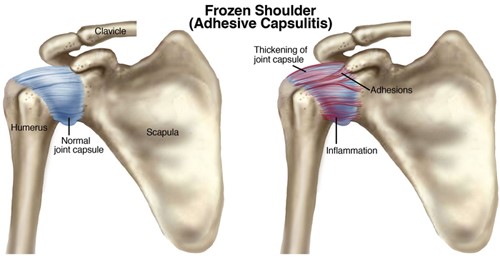WHY DO I HAVE SHOULDER PAIN
You haven’t done anything to hurt your shoulder. However, you may find yourself unable to move your shoulder and it may cause serious pain if you try. This is a condition known as Frozen Shoulder, and it can greatly affect your daily life.
Frozen shoulder, also known as Adhesive Capsulitis is a condition that leads to a painful loss of range of motion in the shoulder joint.
SYMPTOMS
It causes persistent shoulder pain, inflammation and stiffness in the connective tissue of the shoulder. Therefore, the condition is known to gradually worsen over time.
These persistent symptoms can make daily tasks extremely painful and challenging.
Frozen shoulder causes the capsule surrounding the shoulder joint to contract and form scar tissue, which causes a painful restriction in range of motion. However, without proper treatment, this shoulder condition can last for years.
Things you should do to Heal Your Frozen Shoulder
Frozen Shoulder can be caused by many different factors but it always results in pain and reduced motion.
HOW LONG SHOULD IT TAKE FOR A FROZEN SHOULDER TO HEAL?
Frozen Shoulder, on average, can take between 6 months to 2 years, to heal. If you don’t want to suffer for the next 2 years and take painkillers that really don’t help much, follow these tips:
TIPS TO HEAL
• Pay Attention to Your Posture and Sleeping Position
If you have frozen shoulder, you are vulnerable to reduced sleep quality.
This is especially true during the first stage or the freezing stage, which is the phase when you will feel the most pain.
However, getting adequate sleep promotes healing and reduces inflammation.
To help you stay comfortable as you sleep, you can put a pillow under your affected arm, with your hand resting on your stomach.
If you tend to sleep on your side, make sure you don’t sleep on your affected shoulder. In addition, place your affected arm on a pillow across your chest as if hugging it.
When you are standing or sitting, make sure you have good posture. Keep your shoulders back and avoid slouching or slumping to help ease your pain.
• Regularly Use Your Affected Arm
WILL IT HELP TO KEEP YOUR SHOULDER IMMOBILE?
Keeping your arm and shoulder idle will not help with the healing process. Moreover, resting these parts all the time will only worsen your condition.
One of the most common causes of a frozen shoulder is reduced or total immobility, which may be due to factors like a broken arm, stroke, recovery from surgery, or a shoulder injury. As a result, if you keep your arm and shoulder immobile, the capsule that encases the joint thickens and tightens.
EXERCISE AS THERAPY
On the other hand, if you perform gentle exercises as prescribed by your therapist, you can improve your shoulder’s strength and range of motion.
• Stretches
Keep your shoulder moving throughout the day
Stretches may help to increase flexibility, improve range of motion, and prevent injury. Some examples of stretches includes the following:
Firstly, standing arm lifts
1. Make fists with your hands and bring them in front of your hips.
2. Inhale as you lift your arms overhead so your hands come together above your head.
3. Lower your arms down to the original position.
4. Repeat 10 times.
Secondly, cross arm stretch
1. Bring your left arm across the front of your body at about chest height.
2. Support your left arm with the elbow crease of your right arm or use your right hand to hold your left arm.
3. Stretch out your shoulder and continue to face forward.
4. Hold this stretch for 30 seconds.
5. Repeat on the opposite side.
Lastly, shoulder rolls
1. Maintain good posture while standing or sitting.
2. Roll your shoulders up, back, and down.
3. Do this movement 10 times.
4. Then, roll your shoulders up, forward, and down 10 times.
PHYSIOTHERAPY AS TREATMENT
• Do Not Skip Your Physical Therapy Sessions
One of the most important aspects of your treatment plan is physical therapy.
Physiotherapist will teach you exercises that focus on stretching the joint capsule. As a result, when your condition improves, you can move on to strengthening exercises.
In conclusion, if you have a frozen shoulder, make sure you attend all physical therapy sessions to keep your progress on track.
If you would like to learn a bit more about your shoulder , this will show you a bit more : https://teachmeanatomy.info/upper-limb/joints/shoulder/
DON’T WAIT TO START PHYSIOTHERAPY TREATMENT
However, If you notice tension or tightness in your shoulders, it’s important to take steps to relieve the tension as soon as possible. As a result, early treatment can reduce the risk for complications.
In conclusion, it’s a good idea to exercise, to loosen up your shoulders even if you don’t have severe tightness. Try to bring your awareness to this area of your body throughout the day, and work on relaxing and releasing tension.
If you’re experiencing long-lasting or intense pain, Book a consultation at PhysioNOW with a Registered Physiotherapist today.




